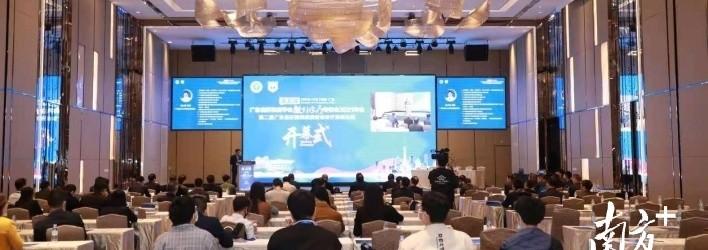On December 11, the 2021 Annual Meeting of the 5th Guangdong Society of Hepatology Minimally Invasive Diagnosis and Treatment And the 2nd Guangdong Provincial Hepatobiliary and Pancreatic Minimally Invasive Diagnosis and Treatment Summit Forum were held in Guangzhou, sponsored by the Guangdong Hepatology Society, the Minimally Invasive Treatment Committee of the Guangdong Hepatology Society, and the Affiliated Cancer Hospital of Guangzhou Medical University.
This conference focuses on the clinical research of hepatobiliary and pancreatic diseases, new technologies for treatment, and the latest progress in preoperative targeted and immune combination translational therapy, etc., and conveys the research trends and clinical application progress in the minimally invasive diagnosis and treatment of hepatobiliary and pancreatic diseases at home and abroad.

The scene of the conference
Minimally invasive is the development direction of hepatobiliary and pancreatic disease treatment
In recent years, minimally invasive surgery with endoscopic technology as the core has developed rapidly, and the advantages of laparoscopy in the treatment of hepatobiliary and pancreatic tumors have become more and more obvious. Laparoscopic hepatic resection and laparoscopic pancreatic resection can fully reflect the technical level and comprehensive strength of minimally invasive surgery in the hospital. Professor Cui Shushu, chairman of the conference and president of the Affiliated Cancer Hospital of Guangzhou Medical University, pointed out that because the liver is large, the blood vessels and bile ducts in the liver are dense, the pancreas site is deep, and the pancreatic tumor is easy to invade neighboring organs and blood vessels, hepatobiliary and pancreatic surgery is very difficult. With the improvement of laparoscopic technology and the popularization of application, there are currently about 60% of hepatobiliary and pancreatic diseases, especially hepatobiliary and pancreatic tumors can be solved by minimally invasive surgery, that is to say, in the past, the traditional surgery that required a nearly 30 cm incision in the abdomen was now used laparoscopic technology, only 4-5 1 cm size holes in the abdominal wall can be opened to complete hepatectomy and pancreatic resection, which greatly alleviates the pain of patients and shortens the hospitalization time and recovery time of patients.
Professor Cui Shushu, President of the Affiliated Cancer Hospital of Guangzhou Medical University
"At present, the treatment of hepatobiliary and pancreatic tumors is still mainly surgery, but the continuous research and development of new drugs such as targeted therapy and immunotherapy, as well as the advancement of technologies such as radiofrequency ablation and body cavity heat perfusion therapy, have also provided more methods and means for the minimally invasive treatment of hepatobiliary and pancreatic tumors." Professor Cui said.
New technologies and new equipment have brought minimally invasive diagnosis and treatment to a new level
The improvement of the level of minimally invasive diagnosis and treatment of hepatobiliary and pancreatic diseases is inseparable from the blessing of innovative technology. Professor Tang Yunqiang, chairman of the Minimally Invasive Diagnosis and Treatment Committee of the Guangdong Hepatology Society and executive chairman of the summit, pointed out that although the advantages of laparoscopic surgery in the minimally invasive diagnosis and treatment of hepatobiliary and pancreatic diseases are obvious, the limited mobility of laparoscopic surgical instruments, two-dimensional imaging systems and ergonomics have restricted their further development. In recent years, scientific and technological innovation and the improvement of technical equipment have become the driving force for the technological progress of minimally invasive diagnosis and treatment of hepatobiliary and pancreatic diseases.
Professor Tang Yunqiang, Chairman of the Minimally Invasive Diagnosis and Treatment Committee of the Guangdong Society of Hepatology and Executive Chairman of the Summit
Professor Tang Yunqiang introduced, "New technologies such as fluorescence development technology, three-dimensional virtual endoscopy, high-definition laparoscopy and even da Vinci surgical robots have been applied in some large hospitals and centers in the province, thus breaking through the bottleneck of traditional laparoscopic surgery and promoting the level of minimally invasive diagnosis and treatment of hepatobiliary and pancreatic diseases to a new level." ”
Professor Li Fushan, honorary president of the Guangdong Hepatology Society, said that the conference has built an excellent academic exchange platform, hoping to promote the scientific research level and clinical level of the hepatobiliary and pancreatic surgery team through the conference, so that the minimally invasive diagnosis and treatment of hepatobiliary and pancreatic diseases in the province will be brought to a new level.
【Reporter】 Ou Xujiang
【Author】 Ou Xujiang
Healthy living circle